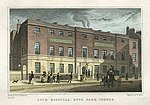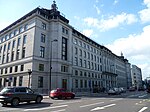Buckingham Palace Garden is a large private park attached to the London residence of the monarch. It is situated to the rear (west) of Buckingham Palace, occupying a 17 hectares (42 acres) site in the City of Westminster and forms the largest private garden in the capital. It is bounded by Constitution Hill to the north, Hyde Park Corner to the west, Grosvenor Place to the south-west, and the Royal Mews, Queen's Gallery, and Buckingham Palace itself to the south and east.
The royal connection to the site of the garden dates from 1609 when James I purchased four acres of land "near to his palace of Westminster for the planting of mulberry trees". The garden covers much of the area of the former Goring Great Garden, named after Lord Goring, occupant of one of the earliest grand houses on the site. In 1664 Goring's mansion, and the lease on the grounds, was bought by Henry Bennet, 1st Earl of Arlington. In 1674 the house was destroyed by fire and Arlington built a replacement, named Arlington House, on the site. This house was sold by Arlington's daughter to John Sheffield, Earl of Mulgrave. Created Duke of Buckingham and Normanby in 1703, Buckingham commissioned a new mansion for the site, named Buckingham House. His architect was William Talman and his builder William Winde. Similar attention was paid to the landscape, where Buckingham engaged Henry Wise to lay out an elaborate garden in the French style, with parterres and a central canal. In the late 18th century, Buckingham House was acquired by George III whose heir, George IV used John Nash to remodel the house which was renamed Buckingham Palace. Nash engaged William Townsend Aiton to implement designs for a new garden. Aiton's work forms the basis of the garden that exists today.
Buckingham Palace Garden is the setting for the Queen's annual garden parties. In June 2002 she invited the public into the garden for entertainment for the first time during her reign. As part of her Golden Jubilee Weekend thousands of Britons were invited to apply for tickets to Party at the Palace where the guitarist Brian May of the band Queen performed his God Save the Queen guitar solo on top of Buckingham Palace. This concert was preceded the previous evening by a Prom at the Palace. During the Queen's 80th birthday celebrations in 2006 the garden was the scene of Children's Party at the Palace.
The garden is Grade II* listed on the Register of Historic Parks and Gardens. The planting is varied and exotic, with a mulberry tree dating back to the time of James I. Notable features include a large 19th-century lake which was once graced by a flock of flamingoes, and the Waterloo Vase. There is also a summerhouse attributed to William Kent, a helicopter landing pad on the great lawn below the West Terrace, and a tennis court. Unlike the nearby Royal Parks of London, Buckingham Palace Garden is not usually open to the public. However, when the palace is open during August and September, visitors have access to part of the garden, which forms the exit, via a gift shop in a marquee, at the end of the tour.










